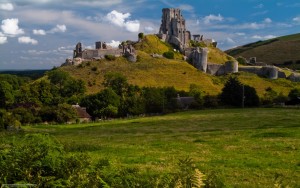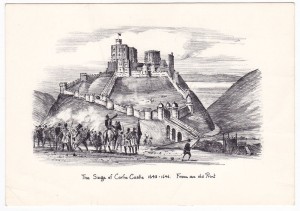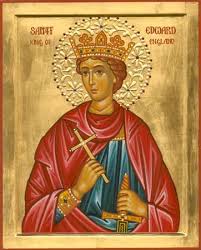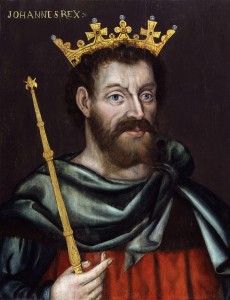Imagine the scene.
It’s March 18th and the late winter air strikes cold on your cheeks, but the sun is filtering through the morning mist as you ride uphill towards a castle gate.
You’re whistling, in order to show you haven’t a care in the world. Well, OK, you may have just a few. Well, OK, but really not too many. Well, OK, perhaps a lot. After all, you’ve been king of an unruly land for three years, you’re still only fifteen years old and you’re approaching what you sense may be a sticky reunion with your 10-year-old half-brother. Unfortunately, your stepmother thinks he should be king, because she was your dad’s official wife.
But you are the eldest son, and all the people chose you to be king when Edgar died. Well, OK, most people chose you. Well, OK, some people chose you. Well, OK, perhaps just a handful of kingmakers chose you and quickly had you declared king…
What will happen next on this brisk sunny day is not going to be pleasant, but you will at least be able to take comfort in the way it will transform you, almost overnight, from a teenage boy with a reputation for a nasty temper that has fuelled your wild rages and violent speech, into a widely revered saint. Your cult following will soon extend throughout Europe, from the Catholic to Russian Orthodox church.
Meanwhile your half-brother will grow up to be known as King Aethelred the Unready, and his royal reputation will go from bad to worse, until some late 20th century historians resuscitate his memory and suggest he may not have been an unmitigated disaster, even though he couldn’t keep the Danes out of England. After all, who could?
And your stepmother? Ah yes, Aelfrida. She will reign as queen regent for six years, until her son turns sixteen but, whether or not she had anything to do with your murder, she will find herself stuck in the role of archetypal wicked stepmother, which will inspire storytellers and Disney movie makers for the next thousand years or so.
For it’s the year 987, we’re at Corfe Castle, Dorset, in England, and a dastardly deed is about to be done to Edward the Martyr King, as he dismounts in the West Bailey, by a Saxon hall of which only the post holes remain today.
That location is the same as the one where, nearly seven centuries on, a child heiress called Frances Coke (maybe) meets a young highwayman-to-be and later inspires a tale called Nights of the Road. And the reason I’m highlighting Corfe Castle in this week’s blog is because Nights of the Road has just appeared in its first printed edition. While e-book readers are one of the Seven Wonders of our 21st century Virtual World, there’s something about holding a physical book in your hand that makes it feel real.
So my blog today acknowledges and celebrates the physical place from which this novel drew so much of its inspiration, early and late, and the spirits of several ancestors that infuse it.
Corfe Castle was built on a hill that stands in the gap of a line of chalk hills, formed by two streams eroding the rock on either side. The name Corfe derives from Old English ceorfan, meaning ‘a cutting’. I first climbed through the mist and up that steep hill where Edward the Martyr rode to his unsuspecting death when I was eight years old. I realise now how fortunate I was to have a father who delighted in sharing his passion for history, as he told me about the Boy King Edward and his unhappy end. At the time, I thought that everybody’s father entertained their children with such stories.
 The National Trust had yet to wave their magic wand over this and similar ancient sites of Britain. Most of the hill forts and castles and churches we visited in my childhood years were deserted and we never paid a penny to visit them. Few of our compatriots seemed to share our desire to visit ruins at that time, perhaps because it felt too close to home: much of urban Britain, after all, was still trying to clear the rubble-ridden residue left over from World War II. Whatever the reason, I loved that my dad and I had such places to ourselves. It’s easy to feel nostalgic for a childhood when one could commune alone and uninterruptedly with the stones and spirits of place.
The National Trust had yet to wave their magic wand over this and similar ancient sites of Britain. Most of the hill forts and castles and churches we visited in my childhood years were deserted and we never paid a penny to visit them. Few of our compatriots seemed to share our desire to visit ruins at that time, perhaps because it felt too close to home: much of urban Britain, after all, was still trying to clear the rubble-ridden residue left over from World War II. Whatever the reason, I loved that my dad and I had such places to ourselves. It’s easy to feel nostalgic for a childhood when one could commune alone and uninterruptedly with the stones and spirits of place.
Corfe Castle had me in its thrall at our first hello, although I did not know then that it would prod me to write about it in adulthood. Nor did I know that the murder of Edward as described by my father was neither the only, nor necessarily the single most dastardly, deed associated with the castle’s story. By the time it was rebuilt in stone for Henry 1st and its dungeon made more secure, the scene was set for other gruesome acts of cruelty. One of them would involve my own ancestors as both victim and perpetrator.
By any standards, French-born Maud de St Valery was a strong woman. Among her more widely publicized exploits was to hold one of husband William de Braose’s castles – the appropriately named Pains Castle – for three weeks against a furious onslaught from Gwenwynwyn, Prince of Powys, during which some 3,000 – or perhaps it was only 300 or less? – Welshmen were said to have met their end. Maud achieved this and similar feats while reputedly also filling her lord’s nursery with 16 children.
Originally both husband and wife were court favorites. William fell foul of King John over monies owed to the Crown and Maud through her loudly voiced suspicions of the part her monarch may have played in the death of his nephew, Arthur of Brittany. It was at John’s orders that Maud was captured and incarcerated in 1210, along with the oldest of the Braose sons, also a William.
Documents of the day suggest that Windsor was their initial prison, but a report in the anonymous Histoire des Ducs de Normandie et des Rois d’Angleterre, written in the 1220s, possibly by a mercenary in the entourage of Baldwin of Béthune, described how the king later ordered the mother and son to be enclosed in a room in Corfe Castle, with a sheaf of wheat and a piece of raw bacon. On the eleventh day their prison was opened and they were found dead, with Maud’s head on William’s breast. The account may be disputed, yet the stones and cellular memory whisper to me that Corfe was indeed the site of Maud’s death…
A more recent tale of the place has to do with another strong woman who proved her ability to resist a siege. In 1643, the mother of a reported 14 children, Lady Mary Bankes, defended the property that her husband Sir John had lately bought from Frances Coke’s mother, Lady Elizabeth Hatton. Leading 80 men, Mary withstood a six-week siege at Corfe Castle, when at least 100 Roundheads were reported killed before the Parliamentarians reluctantly abandoned their efforts.
 Her husband, who was Lord Chief Justice and Attorney General to Charles 1st, died in Oxford in 1644, a few months before Frances Coke, but Mary held Corfe during three years of Civil War until 1646 when, in the unkindest cut of all, she was betrayed from within. One of her own officers turned traitor and let enemy troops disguised as Royalist reinforcements into the castle.
Her husband, who was Lord Chief Justice and Attorney General to Charles 1st, died in Oxford in 1644, a few months before Frances Coke, but Mary held Corfe during three years of Civil War until 1646 when, in the unkindest cut of all, she was betrayed from within. One of her own officers turned traitor and let enemy troops disguised as Royalist reinforcements into the castle.
Her enemies saluted Mary Bankes for her bravery by allowing her to retain the castle keys. In the portrait below, redolent of symbolism, she wears widow’s weeds and holds the keys in her right hand, with the landscape background depicting Corfe Castle.
When the monarchy was restored in 1660, Mary and family received back their estate but unfortunately not in the same state they had left it.
Rather than try to restore a castle that had been so seriously slighted by Cromwell’s forces, Mary and son Ralph elected to build a new house on their Kingston Lacy lands.
Mary did not live to see that mansion completed, but her keys of Corfe Castle are still there today, as is a magnificent collection of paintings, sculptures and the largest private collection of Egyptian artifacts in the UK. www.nationaltrust.org.uk/kingston-lacy/
It is thanks to efforts of the National Trust – and entrance fees paid by today’s visitors – that so many priceless items can be maintained and placed on public view here and elsewhere among Britain’s many stately homes.
Less than twenty miles away from Kingston Lacy, the ruins of Corfe Castle continue to dominate and guard that gap in the Purbeck Hills. Today many thousands of people come each year to wander and hear haunting stories that the ancient stones have to tell.
This year, at the end of March and again in April, the National Trust will offer visitors a chance to learn how mediaeval archery was used during an earlier, less well-known siege of Corfe. In 1139, another of my ancestors, Baldwin de Redvers, withstood King Stephen’s efforts to wrest the Castle from him as he supported Empress Matilda’s attempt to secure the throne her father bequeathed her. Those of a tender disposition and sweet tooth may prefer to visit during Easter weekend and follow an Egg Trail instead! http://www.nationaltrust.org.uk/corfe-castle/things-to-see-and-do/
Thanks so much for taking the time to read this personal tribute to some of my ancestors and spirits of physical place, in celebration of a special moment in the physical life of Nights of the Road!











